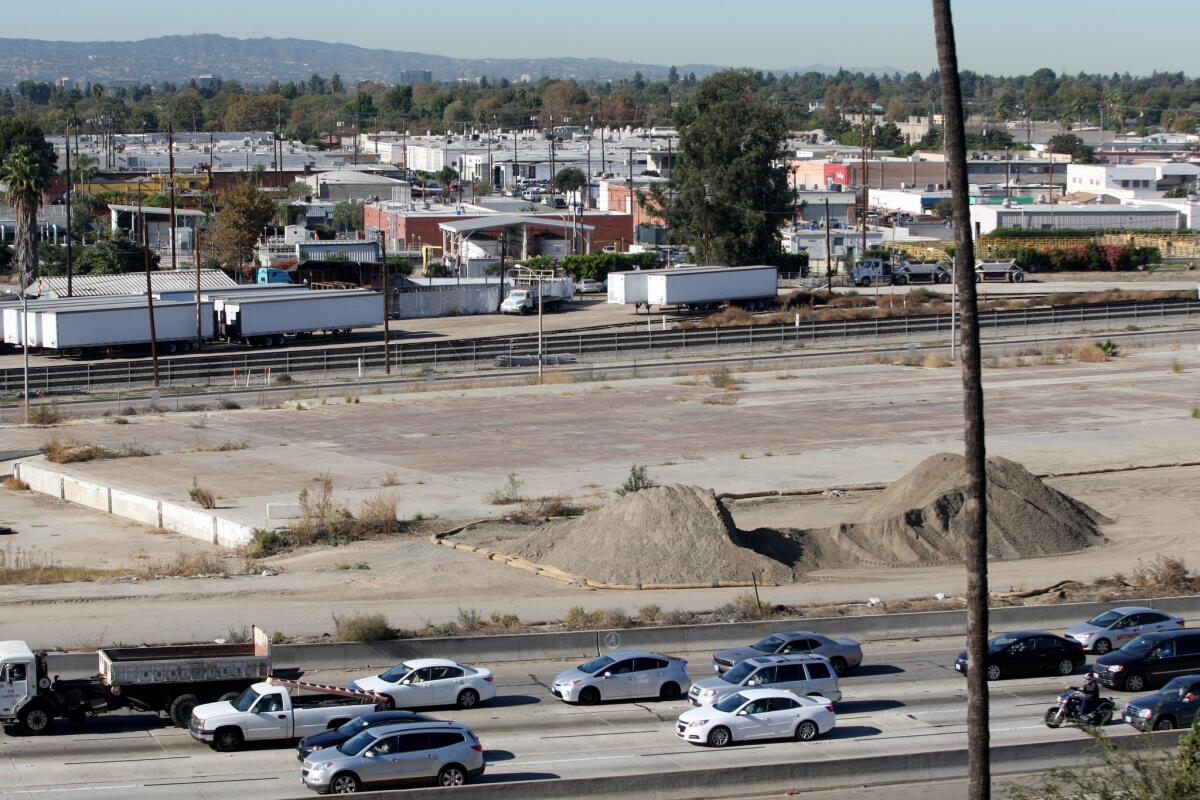While development booms in Burbank and Glendale, some properties sit empty

Throughout Burbank and Glendale sit vacant or little-used properties, dusty and seemingly forgotten. Given the nature of the real estate market, these underutilized lots seem more-than-passing strange, begging the question of how they got to their current state and why. Below are the stories of some of the more prominent “ghost properties” in the Media and Jewel cities.
Burbank: Galpin Ford
A battered concrete slab on a weed-grown 12-acre property is all that’s left of what was formerly a Zero Corp. operation on Front Street in Burbank, between the Golden State (5) Freeway and the railroad tracks south of Burbank Boulevard.
The manufacturer moved the operation to Utah in 1991 and leased the site out for the next several years until Ford Leasing Corp. bought 8 acres of it in 1998 for $12.75 million. The city owns another 4 acres and had been prepared to vacate its easement on the land to include it in a proposed $40-million Galpin Ford auto sales super center.
The City Council cobbled together $12.5 million in incentives for the dealership, including a $3-million loan to Galpin Ford, the largest Ford dealership in the country, contingent on the start of construction. Officials hoped it would bring in $55 million in tax revenues and 300 jobs over the following 25 years.
“We are very excited about this,” then-Mayor Bob Kramer told the Los Angeles Times in March 1998. “It’s going to create a lot of new sales tax for the city and new jobs. And finally, people in Burbank can buy cars here. That will keep more money in the city.”
The early 1990s in Burbank saw an exodus of several large companies, including Zero, Lockheed and Menasco Aerospace. Roughly 58-acres of the former Lockheed “B6” site, which has been used mainly for vehicle parking over the past decade, was recently sold for $72.5 million to real estate developer Overton Moore Properties.
Menasco’s former property on San Fernando was for a time home to Western Studio Service, which stored studio props and other materials, but it is now the site of a future IKEA building under construction, which is expected to bring the city more sales tax revenue and about 100 jobs.
Near the end of the 1990s, with only one new car dealership — Community Chevrolet on Olive Avenue — Burbank was “leaking” sales tax as city residents traveled to North Hollywood and Glendale to make their purchases, said Ruth Davidson-Guerra, Burbank’s assistant community development director, in an interview this week. Galpin Ford was expected to “put a plug in what was leaking out.”
“There were a lot of high hopes back in the day,” Davidson-Guerra said. “It would have been a great infusion of cash into the city’s General Fund.”
Bud Ovrom, Burbank’s city manager at the time, said this week that the city’s tax revenues in all categories but auto sales were strong at the time, sometimes two or more times stronger than the state average. When it came to auto sales, however, it was below the per-capita average and the city adopted a strategy to “bolster our weaknesses.”
The Natelson Study, an in-depth analysis of Burbank’s economy in 2000, found the city was missing out on $75 million a year in potential auto-dealership revenues.
In addition to the loan and the land, Burbank agreed to give the dealership half of the city’s share of the sales tax generated by auto sales at the business for 10 years or up to $9 million. Galpin Ford would receive only 25% of the sales tax income, however, until the loan was repaid, at 6.5% interest.
The property was zoned exclusively for a new auto dealership — fairly restrictive zoning, said City Manager Mark Scott this week — but the dealership didn’t materialize.
“It was approved, but then nothing ever happened,” Davidson-Guerra said.
About eight months after the city approved the incentive package, Galpin Ford owner Bert Boeckmann notified city officials that Ford Motor Co. had scrapped its plans to build as many as four Valley auto outlets.
Ovrom said the city courted other dealers, but Boeckmann decided that if he couldn’t build a dealership on the property, he wouldn’t let anyone else.
“For reasons beyond [the city’s] control, it just didn’t work out,” Ovrom said, adding that the city should “probably give up the hope” of putting another dealer there.
A Ford Motor Co. official declined to comment last month, referring inquiries to Galpin Ford. Representatives of the dealership did not respond to repeated requests for comment, though a woman who answered the phone at the office of Alan Skobin, vice president and general counsel for the company, said he was out of the office recovering from a surgery earlier this month.
Kramer, now an employee of the city, also declined to comment.
“It is not my position to speak to reporters,” Kramer said, offering to find another city official to discuss the issue.
A proposal came in December 2001 for a two-story, 300,000-square-foot building with a Sam’s Club on the ground floor and Wal-Mart on the second floor. The combination store could generate $200 million a year in sales, Ovrom said in a Burbank Leader story at the time.
In 2002, then-Mayor David Laurell wrote to Ford pleading with company officials to sell the property or swap it with the city so that it could be developed.
By 2004, the half-dozen buildings totaling more than 280,000 square feet had been razed and still the dealership didn’t follow. One of the few things the property has been used for in recent years is as a location when the circus comes to town.
“Other than Cavalia, not much is going on there,” said Gary Olson, president and chief executive of the Burbank Chamber of Commerce.
Davidson-Guerra said Cavalia and Circus Vargas shows hosted on the property “kind of helped the cause on a temporary basis” by bringing people to the city. There has been other interest throughout the years, Davidson-Guerra said, but she said the City Council seemed reluctant to rezone the property.
The California Department of Transportation is also using part of the property temporarily while crews make improvements to the Golden State (5) Freeway near Empire Avenue.
Once that’s complete, there may be renewed interest in the property, Davidson-Guerra said, especially in light of the fact it’s “steps” from the Burbank Metrolink Station, the region’s second-busiest station for the commuter rail line.
“The site has a lot of potential,” she said, noting that it could be ideal for mixed-use development that would include housing, for which the city is in “desperate need.”
Ovrom said he thinks it’s time the city look at other commercial uses beyond an auto dealership.
“It was a good idea at the time — its time has passed,” Ovrom said.
But Ovrom said it’s location near the freeway and the railroad tracks that carry both commuters and freight through the city.
Scott said he believes the property will become “very active” once the state’s high-speed rail authority has figured out its plans for a bullet-train rail line connecting a potential Burbank station to Los Angeles Union Station.
“I do think that property will come into play before long,” Scott said.
Glendale: Marie Callender’s and Masonic Temple
Two vacancies near Glendale’s rapidly developing downtown were picked up for revival this year: a former Marie Callender’s location and the historic Masonic Temple on Brand Boulevard.
The restaurant was built in 1976, while the nine-story Masonic Temple was erected in 1928. They don’t have much in common, yet could be symbolic of the city’s continued emergence from 2008’s Great Recession.
“In a very broad sense, the timing of both is related to the thawing of the real estate market,” said Glendale’s Community Development Director, Philip Lanzafame.
The shuttered Marie Callender’s sits at the corner of Pacific Avenue and Burchett Street, a heavily traversed intersection right off a Ventura (134) Freeway onramp.
It sat vacant for about three years until it was bought for $6 million this spring by new owners who plan on tearing it down and turning it into a Rite Aid pharmacy.
The structure is one of the few commercial buildings on Burchett, which is mostly made up of single-family homes and apartments. Some of those residents raised concerns about traffic impacts of the pharmacy, but city officials approved the plan last month.
The Marie Callender’s closed in 2012 after the chain filed for bankruptcy. The former franchisee didn’t give up right away and converted the eatery into the short-lived Bar & Grill.
After that, it was silent but for passing cars.
Despite its prime location, Lanzafame said many things could have prevented the property from being snapped up. He noted a common challenge is whether a building from the past has an appropriate use in the present.
“A property that may have been developed some time ago, for whatever reason, the configuration doesn’t fit what we’re looking for today,” he said.
The length of time it took to get a project going at the site was a surprise to Glendale Chamber of Commerce President Judee Kendall, but she said the Great Recession may have put a pause on things.
While she would have liked to have seen another restaurant go in, a Rite Aid could be useful to the new residents who will be living in downtown developments along nearby Central Avenue.
A little more than a mile southeast sits the 9-story Masonic Temple at 234 S. Brand Blvd. which has sat idle for decades. Little has happened there besides A Noise Within doing theater shows there from the early 1990s through 2011.
Its floors had different heights with windows scattered on the sides of the building to reflect Masonic values, making it difficult to use.
Lanzafame said the Masonic Temple presented particular challenges to would-be developers.
“In addition to all those other elements you have, you now have the historic nature of the building,” he said. “You’ve got to make all these things line up from financing to usability to compatibility to code; making sure your impacts or any other impacts are mitigated.”
The previous owners of the temple, Frank De Pietro and Sons, wanted to convert it into an office building, but that effort fell through in 2010.
This spring, Caruso Affiliated, developer of the Americana at Brand across the street, stepped into the picture and bought the property. The development company plans to turn the property into office space with a restaurant on the ground floor.
The process has not been without controversy.
The Glendale Historical Society wanted to preserve the asymmetrical layout, but Caruso Affiliated proposed — and officials approved — a more aligned pattern.
Greg Grammer, president of the historical society, said he’s glad the building is being brought back to life and made to sustain 21st-century uses, but some of the changes are radical.
“We are disappointed at the extent of the alterations that were done to the original historical fabric of this building,” he said.
But the development company said it has been sensitive to the property’s historic nature.
”The façade is being rehabilitated to its near-original appearance and all front windows on Brand Boulevard are original with the exception of the ground floor/storefront area,” said Jackie Levy, executive vice president of operations for Caruso Affiliated.

